Herons are graceful aquatic birds that live across North America. They are thrilling to watch in their wetland habitats as they carefully move through vegetation and shallow water. But sometimes they can be challenging to tell apart. Discover 12 types of heron birds and learn how to identify them by appearance, habitat, nest location, and calls.
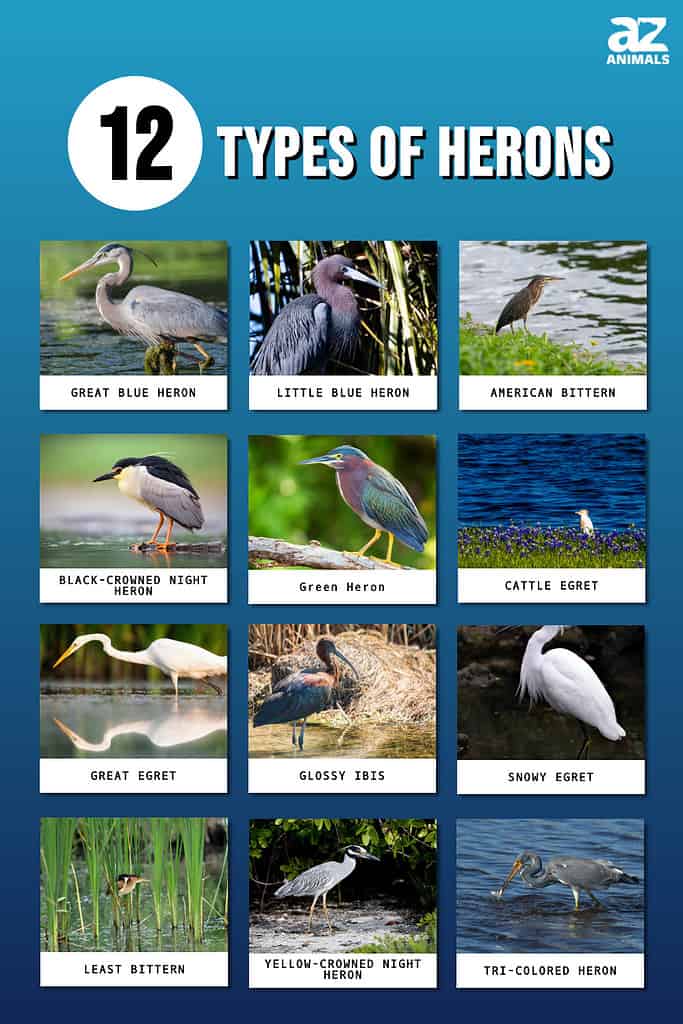
Great Blue Heron
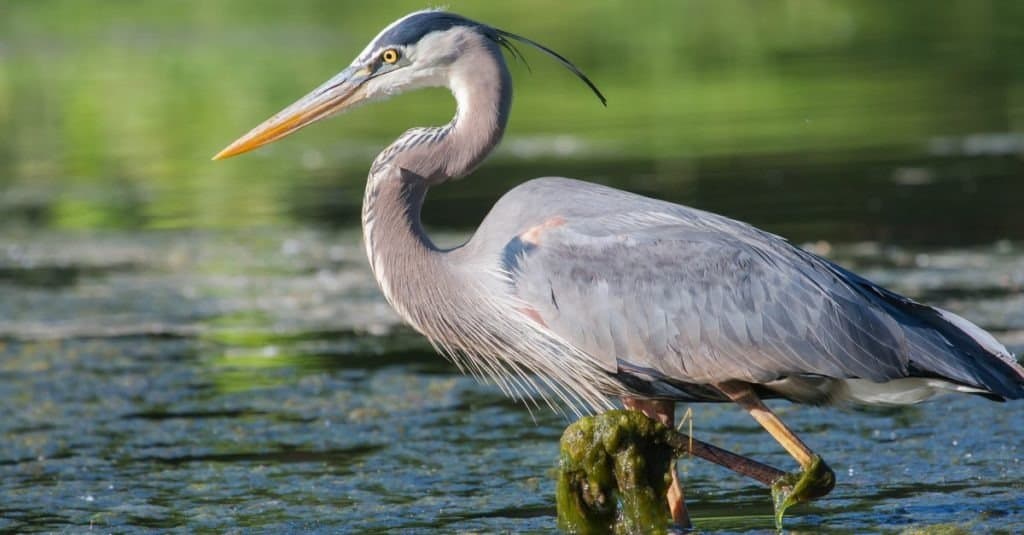
They are the largest North American heron, featuring long legs, curved necks, and dagger-like bills. The great blue heron lives in marshes, swamps, and tide flats.
©Joseph Scott Photography/Shutterstock.com
Habitat: The great blue heron is a year-round resident throughout most of the United States. Populations that breed in northern areas migrate to Mexico for winter. You can find these birds in marshes, swamps, and tide flats.
Appearance: They are the largest North American heron, featuring long legs, curved necks, and dagger-like bills. They are bluish-gray with yellow beaks and black eye stripes.
Diet: Fish, frogs, turtles, snakes, insects, rodents, and birds
Calls: Harsh squawks and croaks
Nest: A stick platform placed in trees above water
Little Blue Heron
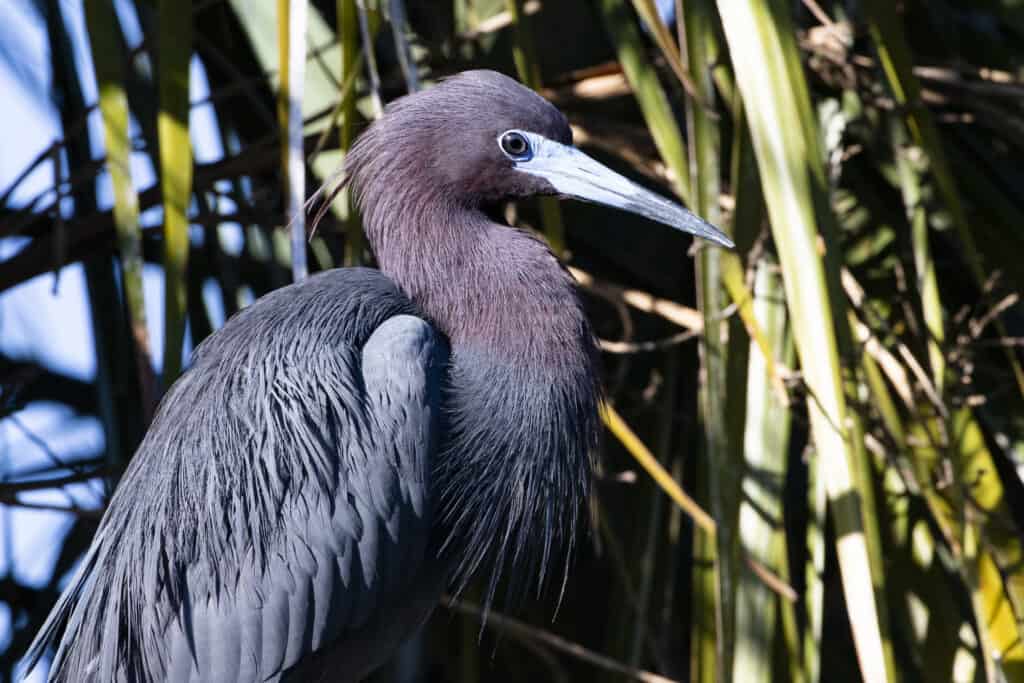
The little blue heron lives along the coast in marshes and swamps. Adults are dark gray-blue with maroon heads and juveniles are all white.
©iStock.com/Florence and Joseph McGinn
Habitat: The little blue heron has scattered populations across the US, where it lives year-round in the southeast along the coast and breeds occasionally in freshwater inland. They inhabit marshes, swamps, rice fields, ponds, and shores.
Appearance: These small herons have slender necks, long legs, and straight bills. Adults are dark gray-blue with maroon heads and juveniles are all white.
Diet: Fish, crustaceans, lizards, frogs, snakes, turtles, and spiders
Calls: Hoarse squawks, croaks, and screams (usually silent)
Nest: A stick platform placed in shrubs or trees
American Bittern

The American bittern lives in extensive freshwater marshes near the Gulf Coast during winter. Northern breeding populations migrate to the southern US and Mexico during winter.
©iStock.com/Marianne Pfeil
Habitat: Northern breeding populations migrate to the southern US and Mexico during winter. They live in freshwater marshes and reedy lakes with plenty of cattails and sedges.
Appearance: American bitterns are medium-sized herons with thick necks, short legs, and a hunched posture. Their plumage is streaky brown, buff, and white.
Diet: Fish, frogs, aquatic insects, crabs, and garter snakes
Calls: Loud pumping sounds
Nest: A grass platform in dense marsh growth
Black-crowned Night Heron

The black-crowned night heron or black-capped night heron has white feathers on its breast along with greyish-black wings. They live in marshes, swamps, and shores.
©Nycticorax nycticorax/Shutterstock.com
Habitat: These herons live in many aquatic habitats, such as marshes, swamps, shores, rivers, and ponds. Populations along the coasts live there permanently and breeding groups can be found throughout the rest of the country.
Appearance: Small, thick herons with flat heads and heavy bills. Adults are light gray with black backs and crowns and yellow legs.
Diet: Fish, crustaceans, aquatic insects, snakes, frogs, rodents, and carrion
Calls: Loud barks and croaks
Nest: A stick platform in marsh vegetation
Green Heron
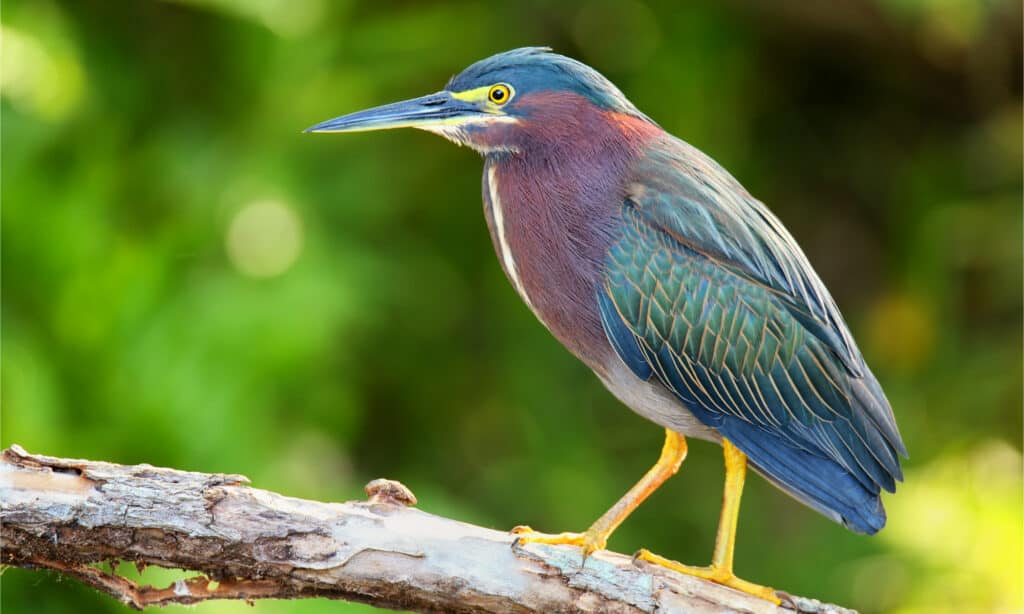
Green herons green backs and wings, though the color can range from black and grey to green or blue. They live in marshes, swamps, and streamsides.
©Don Mammoser/Shutterstock.com
Habitat: You can find the green heron in the eastern United States and along the west coast. Look for them in marshes, swamps, lakes, ponds, and streamsides.
Appearance: They are short, stocky herons with thick necks and broad wings. These birds are difficult to spot because their plumage looks all dark from a distance. But they have deep green backs and caps with chestnut breasts and necks.
Diet: Small fish, aquatic insects, crustaceans, frogs, snakes, and small rodents
Calls: Sharp “skyow!”
Nest: A stick platform in shrubs or trees
Cattle Egret

Cattle egret are small, compact herons with short legs and thick necks. They inhabit marshes, flooded fields, and farms.
©Richard A McMillin/Shutterstock.com
Habitat: Cattle egrets are strongly migratory, moving through most of the United States and breeding in the southeast. You can find them in marshes, flooded fields, farms, and roadsides.
Appearance: They are small, compact herons with short legs and thick necks. They are all white except for the golden plumes on their head, yellow legs, and yellow bills.
Diet: Insects, frogs, spiders, and baby birds
Calls: Hoarse croaks
Nest: Shallow stick bowl in trees or shrubs
Great Egret
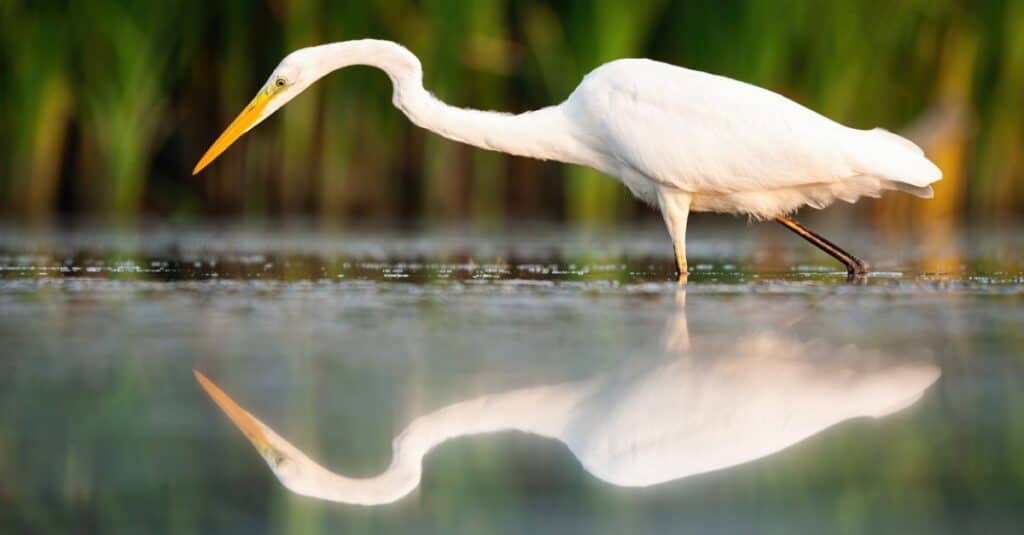
Great egrets are all white with yellow bills and black legs. You can find them in marshes and mud flats across the United States.
©WildMedia/Shutterstock.com
Habitat: Great egrets are scattered across the United States with the most abundant populations in the southeast. They inhabit marshes, ponds, shores, and mud flats.
Appearance: These birds are tall with exceptionally long necks and legs. They are all white with yellow bills and black legs.
Diet: Fish, crustaceans, frogs, snakes, and aquatic insects
Calls: Gutteral croaks and loud squawks
Nest: A stick platform in trees or shrubs near water
Glossy Ibis
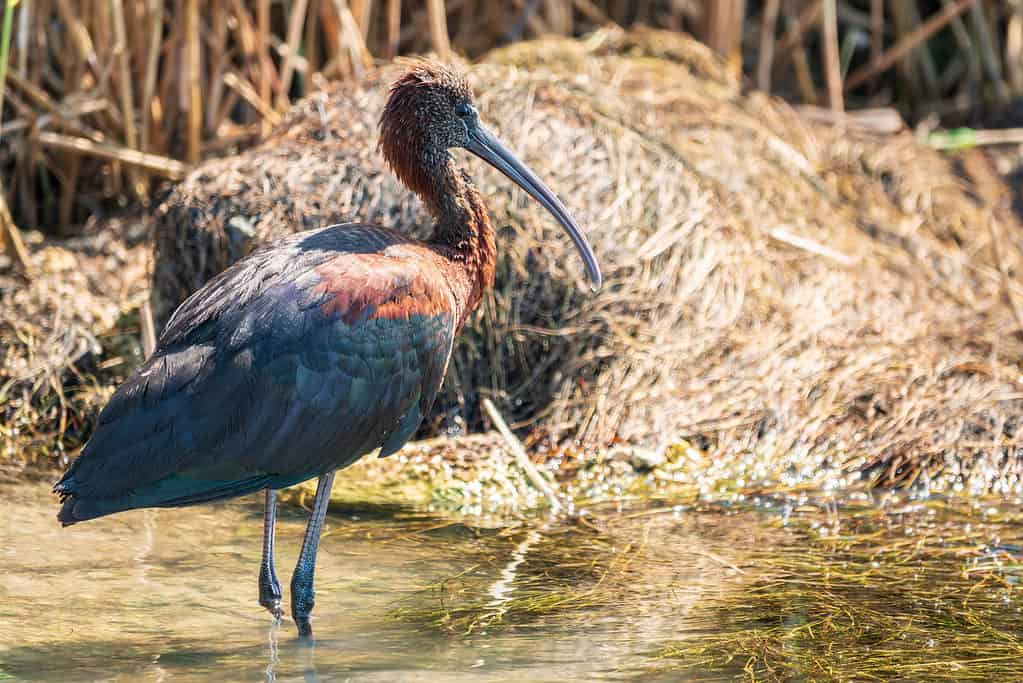
The glossy ibis lives in the southeastern United States along the coast. You can find them in marshes, rice fields, and swamps.
©iStock.com/Dmitry Potashkin
Habitat: The glossy ibis lives along the United State’s eastern coast, where they inhabit marshes, rice fields, and swamps. They will live in either fresh or saltwater.
Appearance: These medium-sized birds are compact with long necks and long legs. Most of their body is rich maroon and their wings are metallic green, bronze, and purple.
Diet: Insects, snakes, snails, crabs, frogs, and fish
Calls: Low grunts and bleats
Nest: A stick platform in low trees over water
Snowy Egret
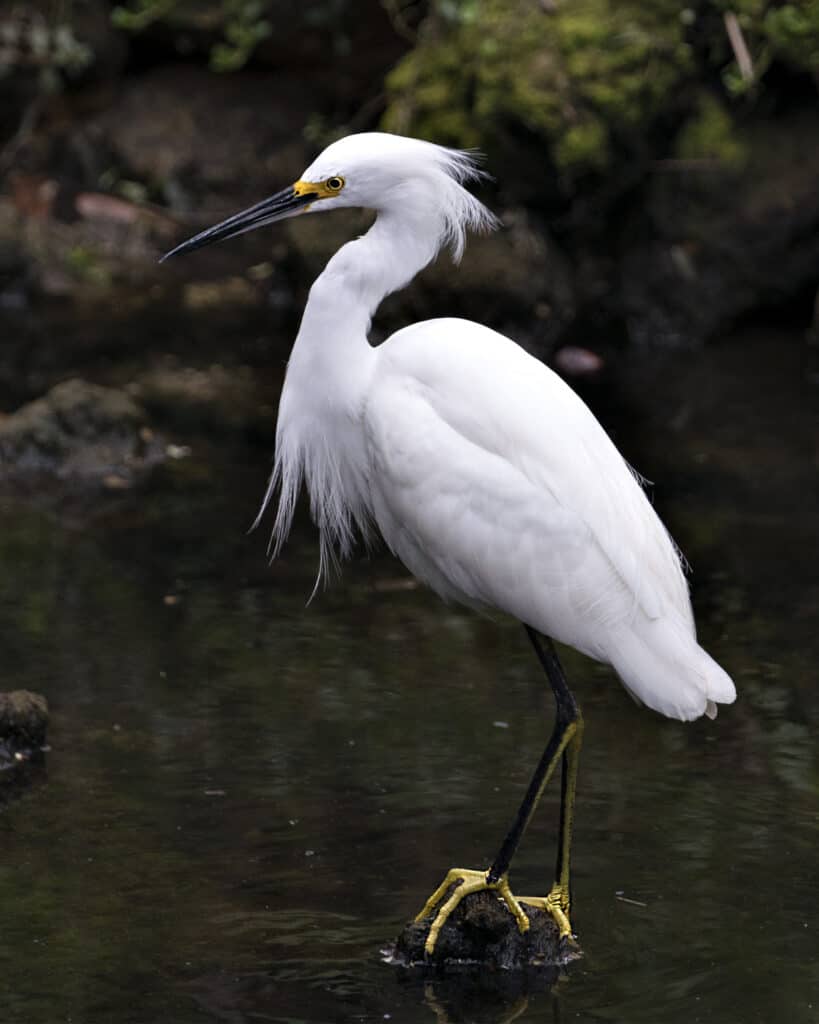
The snowy egret lives on the Gulf Coast and other southern coasts year-round. They live in ponds, swamps, shores, and marshes.
©iStock.com/Rejean Bedard
Habitat: Another bird of southern coasts, the snowy egret inhabits marshes, ponds, swamps, and shores. You will sometimes find them foraging in dry fields.
Appearance: These medium-sized herons have thin legs, slender bills, and small heads. They have all-white plumage black legs, black bills, and yellow feet.
Diet: Fish, insects, and crustaceans
Calls: Harsh squawks and gagging croaks
Nest: A stick platform in trees or shrubs
Least Bittern
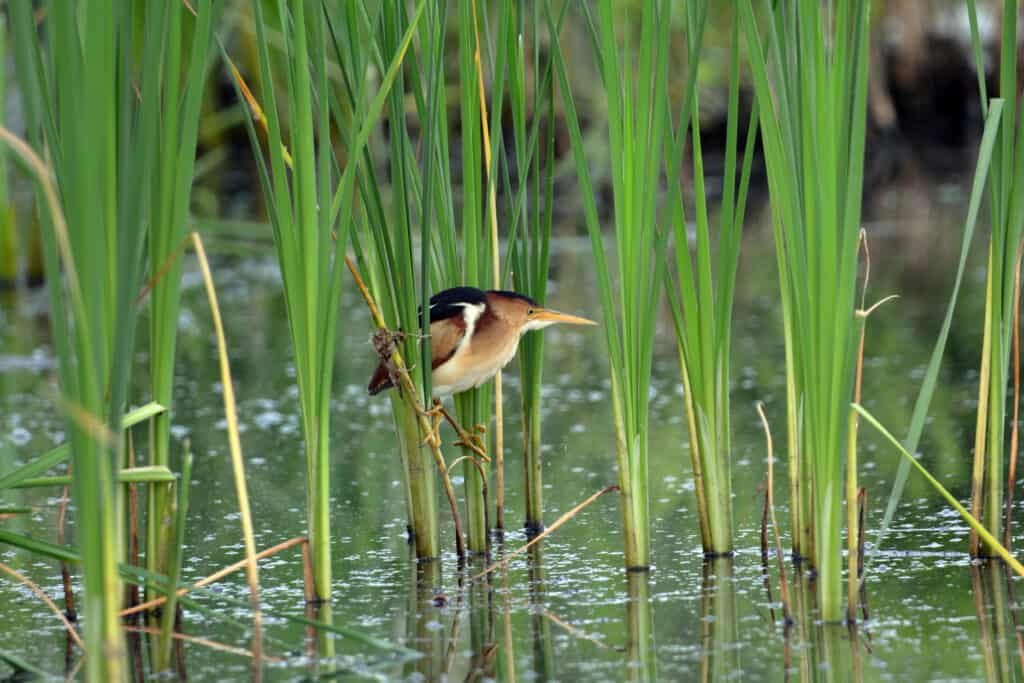
The least bittern is a very small heron found in the eastern United States during the breeding season.
©iStock.com/Carol Hamilton
Habitat: The least bittern breeds in the eastern half of the United States, with some populations living year-round in southern Florida. You will find them primarily in freshwater marshes and reedy ponds, but you can occasionally find them in brackish water.
Appearance: They are very small herons with long toes and dagger-like bills. Adults are grayish-brown above and buff or brown below with white racing stripes and yellow legs.
Diet: Fish, insects, leeches, frogs, and snakes
Calls: Soft coos and chuckles
Nest: A well-concealed platform made from marsh grasses
Yellow-crowned Night Heron
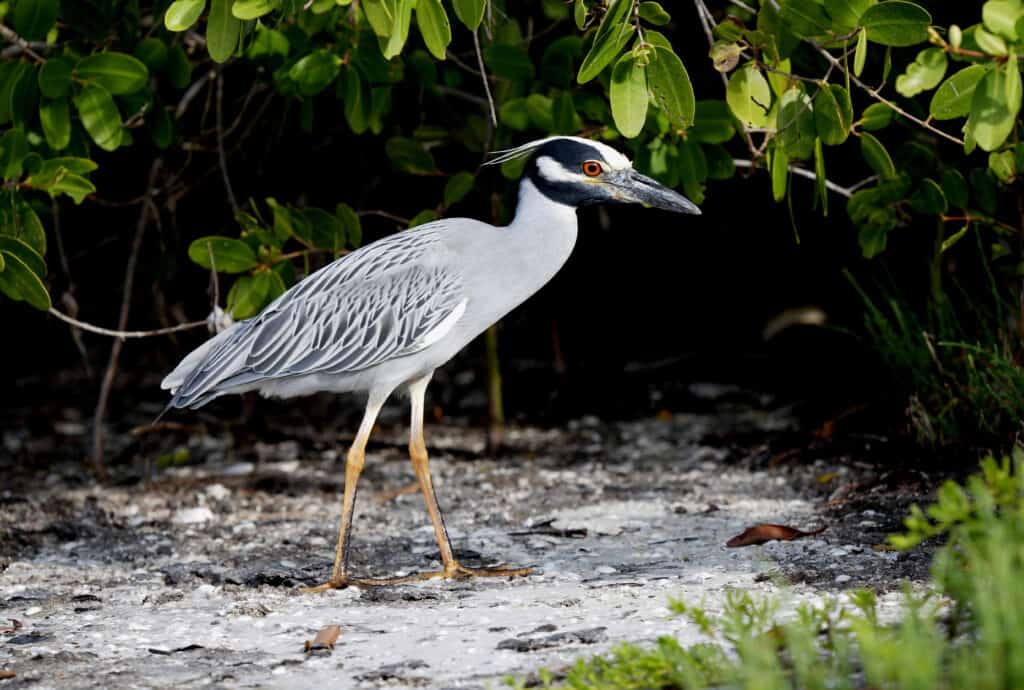
The yellow-crowned night heron breeds in the southeast and lives in cypress swamps, mangroves, and bayous.
©iStock.com/neil bowman
Habitat: The yellow-crowned night heron breeds in the southeast and lives year-round in Florida. You can find them in cypress swamps, mangroves, bayous, and streams.
Appearance: These small herons are stocky with thick necks and short legs. They have streaky gray plumage with black and white faces and yellow-orange legs.
Diet: Crustaceans, frogs, insects, and fish
Calls: Loud high-pitched quacks
Nest: A stick platform in trees over the ground
Tri-colored Heron
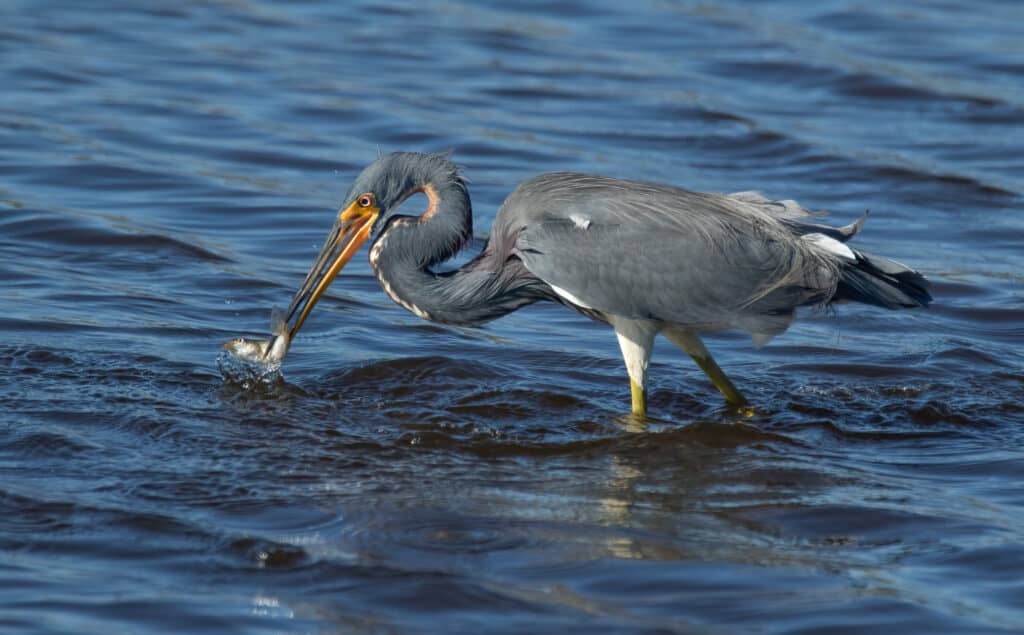
You can find the tricolored heron belly-deep in coastal lagoons. They eat an abundance of small fish.
©iStock.com/MattCuda
Habitat: Tri-colored herons live in saltwater marshes, coastal estuaries, mangroves, and lagoons. They live year-round along the United State’s east coast and the Gulf of Mexico.
Appearance: They are slim, medium-sized herons with long bills and thin, curve necks. They are a mix of bluish-gray and lavender above and white below. Breeding birds have pink legs and nonbreeding birds have yellow legs.
Diet: Small fish
Calls: Scratchy nasal calls and snaps
Nest: A loose twig platform on islands with dense vegetation
What Does Seeing a Heron Mean Spiritually?

Herons symbolize harmony, balance, and good fortune.
©Brian Lasenby/Shutterstock.com
Spying a heron, such a beautifully elegant bird, is a special occasion, and many people believe bird sightings hold symbolism. Herons are birds of good fortune. If you see many herons, abundance is within your grasp. These graceful birds also symbolize balance and self-reliance. They practice stillness, and this is a reminder to be still and mindful. Sometimes the next step in life is to wait. The heron watcher is to be reminded to trust in herself, seek spiritual balance in a chaotic world, and expect good things to happen. The Cherokee believe the heron symbolizes harmony. They thrive in their habitat. Their patience, waiting to snatch a fish when the time is right, is a mindful practice. Humans can learn much from the heron.
Summary of 12 Types of Heron Birds
All of these herons spend at least part of their time in North America near coasts, marshes, ponds, and wetlands.
| # | Heron | Appearance |
|---|---|---|
| 1 | Great Blue Heron | Large, bluish-gray with yellow bills, long legs |
| 2 | Little Blue Heron | Small, dark gray-blue with maroon heads, straight bills, long legs |
| 3 | American Bittern | Medium, thick necks, short legs, hunched posture, streaky brown, buff, and white |
| 4 | Black-crowned Night Heron | Small, thick with flat heads, light gray with black backs and crowns, yellow legs |
| 5 | Green Heron | Short, stocky with thick necks, green backs, and caps with chestnut breasts and necks |
| 6 | Cattle Egret | Small, compact with thick necks, all white with golden plumes and yellow bills, short yellow legs |
| 7 | Great Egret | Tall, exceptionally long necks and legs, all white with yellow bills and black legs |
| 8 | Glossy Ibis | Medium, compact, long necks and legs, maroon bodies with metallic green, bronze, and purple wings |
| 9 | Snowy Egret | Medium, thin legs, slender bills, all white with black legs and bills |
| 10 | Least Bittern | Very small, long toes and dagger-like bills, grayish-brown with white stripes and yellow legs |
| 11 | Yellow-crowned Night Heron | Small, stocky with thick necks and short yellow-orange legs, streaky gray with black and white faces |
| 12 | Tri-colored Heron | Medium, long bills and thin necks, bluish-gray and lavender with pink or yellow legs |
The photo featured at the top of this post is © Don Mammoser/Shutterstock.com
Sources
- Audobon, Available here: https://www.audubon.org/news/ask-kenn-egret-ibis-flamingo-heron-stork-whats-difference
Thank you for reading! Have some feedback for us? Contact the AZ Animals editorial team.






